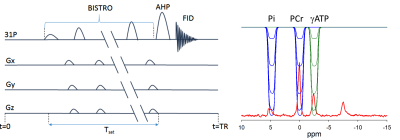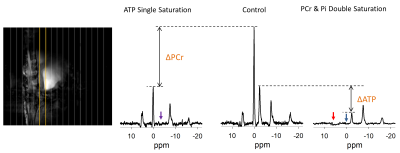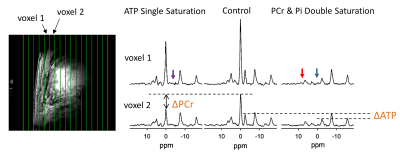1206
Measurement of ATP Hydrolysis Rates in the In Vivo Heart at 7T1Department of Electrical and Computer Engineering, Auburn University, Auburn, AL, United States, 2Biomedical Engineering, The University of Alabama at Birmingham, Birmingham, AL, United States, 3Electrical and Computer Engineering, Auburn University, Auburn, AL, United States
Synopsis
Direct measurement of ATP hydrolysis (ATP-->Pi) were elusive in the in vivo myocardium because the level of Pi in the heart is low and the peak attributed to Pi overlaps with the much larger peak for 2,3-disphosphoglycerate (2,3 DPG). We have demonstrated an approach to measure ATP utilization rate indirectly by measuring total ATP utilization and subtracting out the measurable component that can be attributed to ATP flux via CK. The technique was applied in swine and human hearts at 7T. This method can facilitate important insights into biological mechanisms of impaired bioenergetics in myocardium.
INTRODUCTION:
Heart tissue constantly produces and utilizes high rates of Adenosine Triphosphate (ATP) to maintain normal mechanical function. Impaired ATP production and utilization is potential biomarker of cellular function in heart failure and various other diseases [1-5]. Phosphocreatine (PCr), inorganic phosphate (Pi), and ATP with the γ-, α-, and β resonances are the most common metabolites detected by 31P-MRS. These metabolites compose a chemical exchange network $$$ PCr\rightleftarrows ATP \rightleftarrows Pi $$$ catalyzed by the enzymes creatine kinase (CK) and ATP synthase (ATPase). Measurement of these reaction rates may provide important insights into mechanisms of impaired bioenergetics associated with heart failure. 31P magnetization saturation transfer (MST) spectroscopy experiments have been extensively used to measure rate of CK forward flux ($$$ PCr \rightarrow ATP $$$) in the myocardium [6-8]. However, measuring ATP hydrolysis ($$$ ATP \rightarrow ADP+Pi $$$) is problematic in heart because the level of Pi is too low and the peak attributed to Pi overlaps with the much larger peak for 2,3-disphosphoglycerate. We have previously demonstrated, in open chest animal heart, that ATP hydrolysis flux can be indirectly by measuring total ATP flux and subtracting out the component attributed to ATP flux via CK [9, 10]. We have also validated this technique in human skeletal muscle [11]. In this work we demonstrate the application of the technique in the in vivo swine and human hearts at 7T. The technique will be incorporated with novel MST method ($$$ T_{1nom} $$$) for fast measurement of in vivo enzyme kinetics [9].METHODS:
Experiments were performed on a Siemens 7T Magnetom (Erlangen, Germany) using a dual tuned 31P/1H loop coil in Sinclair mini swine (~50 kg, n=4) and two healthy subjects. All subjects were placed prone in the scanner with the RF coil under the chest to reduce respiratory motion. 31P MR spectra were acquired with acquisition weighted 1D-CSI sequence using a 200 ms hard RF pulse for excitation. Selective saturation of γ-ATP or of both PCr and Pi was achieved by using the B1-insentitive train to obliterate signal (BISTRO) technique [12] (Figure 1). The complete experimental protocol consisted of three experiments, (1) Control spectrum (no saturation) to determine $$$ M_{o,PCr} $$$ and $$$ M_{o,ATP} $$$, (2) Single saturation with γ-ATP saturated to determine $$$ M_{s,PCr} $$$, (3) Spectrum with both PCr and Pi saturated to determine $$$ M_{s,γ-ATP} $$$. Other acquisition parameters were: TR = 6 s, Tsat = 3 s, FOV = 16 cm with 16 phase encoding steps, spectral width = 6 kHz and 1024 data points, 32 averages were acquired in swine (75 min acquisition time) and 16 averages for human experiments (36 min acquisition time). Spectra were processed offline using the jMRUI (Java-based magnetic resonance user interface) software to determine resonance areas for γ-ATP, PCr and Pi. The forward rate constants were determined using $$$ T_{1nom} $$$ method as described before [9] $$ k_{PCr\rightarrow ATP}=\left(\frac{M_{o,PCr}-M_{s,PCr}}{M_{o,PCr}}\right)/T_{1nom}^{PCr}\;\;\;\;\;\;\;\;\;\;\;\;\;(1) $$and the total ATP flux $$k_{ATP,total}=\left(\frac{M_{o,\gamma ATP}-M_{s,\gamma ATP}}{M_{o,\gamma ATP}}\right)/T_{1nom }^{\gamma ATP }\;\;\;\;\;\;\;\;\;\;\; (2) $$ where $$$ k_{ATP,total}=k_{ATP \rightarrow Pcr} + k_{ATP \rightarrow Pi} $$$. ATP hydrolysis rate constant $$$ k_{ATP \rightarrow Pi} $$$ is determined by subtracting $$$ k_{ATP \rightarrow PCr} $$$ from $$$ k_{ATP,total} $$$ where $$ k_{ATP \rightarrow PCr} =\frac{M_{o,PCr}}{M_{o,\gamma ATP}}k_{PCr \rightarrow \gamma ATP} \;\;\;\;\;\;\;\;\;\;\;\;\;\;\;\;\;\;\;\;\;\;\;\;\;\;\;\; (3) $$ Energy fluxes were calculated by multiplying the rate constant with the previously reported metabolite concentrations [9, 10].RESULTS:
Typical MST spectra from swine and human hearts are displayed in Figures 2 and 3. The decline in PCr in response γ-ATP saturation (Experiments 1 and 2) was used to calculate the forward rate constant for the PCr→ATP ($$$k_{PCr->ATP}=0.32\pm0.07 s^{-1}$$$) using Eq 1. The decrease in γ-ATP that occurred due to double saturation of PCr and Pi (Experiments 1 and 3) was used to calculate the total rate constant for the combined ATP→PCr and ATP→Pi reactions and ATP hydrolysis rate constant ATP ($$$k_{ATP->Pi}=0.19\pm0.06 s^{-1} $$$) was determined by subtracting $$$k_{PCr->ATP}$$$ from $$$ k_{ATP,total}$$$. These are in agreement with observations in previously reported values in the mammalian heart [8, 13].DISCUSSION:
We have demonstrated, for the first time, in vivo measurement of ATP utilization flux in the heart. The method does not require need to quantify Pi, which is extremely difficult in vivo. The novel steady-state saturation transfer method ($$$ T_{1nom}$$$) allows accurate reaction rate quantification under partially relaxed conditions thus significantly reducing the scan time. The three in vivo experiments in human study to quantify complete reaction kinetics were acquired in 36 minutes. This method to quantify ATP hydrolysis flux has direct application in cardiac studies and may provide important insights into biological mechanisms of impaired bioenergetics associated with heart diseases. The method can be applied to organs, where Pi is visible, with improved SNR since Pi concentration is typically low and has longer TR.Acknowledgements
We would like to thank Dr. Ronald Beyers for helpful discussion with experimental setup and Dr. Gregory Walcott for helping conduct animal studies.References
1. Schrauwen‐Hinderling VB, Roden M, Kooi ME, Hesselink MK, Schrauwen P. Muscular mitochondrial dysfunction and type 2 diabetes mellitus. Curr Opin Clin Nutr Metab Care. 2007;10: 698–703.
2. Petersen KF, Befroy D, Dufour S, et al. Mitochondrial dysfunction in the elderly: possible role in insulin resistance. Science. 2003;300:1140–1142.
3. Pecoraro M, Pinto A, Popolo A. Mitochondria and Cardiovascular Disease: A Brief Account. Crit Rev Eukaryot Gene Expr. 2019;29(4):295-304.
4. Role of mitochondrial dysfunction in Alzheimer's disease. Castellani R, Hirai K, Aliev G, Drew KL, Nunomura A, Takeda A, Cash AD, Obrenovich ME, Perry G, Smith MA. J Neurosci Res. 2002 Nov 1;70(3):357-60
5. Schapira AH. Mitochondrial dysfunction in neurodegenerative diseases. Neurochem Res. 2008 Dec;33(12):2502-9.
6. Smith CS, Bottomley PA, Schulman SP, Gerstenblith G, Weiss RG. Altered creatine kinase adenosine triphosphate kinetics in failing hypertrophied human myocardium. Circulation. 2006;114:1151–1158.
7. Bashir A, Gropler RG. Reproducibility of Creatine Kinase Reaction Kinetics in Human Heart: A 31P Time Dependent Saturation Transfer Spectroscopy. NMR Biomed. 2014 Jun; 27(6): 663–671.
8. Clarke WT, Robson MD, Neubauer S, Rodgers CT. Creatine kinase rate constant in the human heart measured with 3D‐localization at 7 tesla. Magn Reson Med. 2017 Jul; 78(1): 20–32.
9. Xiong Q, Du F, Zhu X, Zhang P, Suntharalingam P, Ippolito J, Kamdar FD, Chen W, Zhang J. ATP production rate via creatine kinase or ATP synthase in vivo: a novel superfast magnetization saturation transfer method. Circ Res. 2011 Mar 18;108(6):653-63.
10. Xiong Q, Ye L, Zhang P, Lepley M, Tian J, Li J, Zhang L, Swingen C, Vaughan JT, Kaufman DS, Zhang J. Functional consequences of human induced pluripotent stem cell therapy: myocardial ATP turnover rate in the in vivo swine heart with postinfarction remodeling. Circulation. 2013 Mar 5;127(9):997-1008.
11. Bashir A, Zhang J, Denny TS. Phosphate Metabolite T1 Relaxation Times, ATP Hydrolysis Flux and Creatine Kinase Reaction Kinetics in the Human Skeletal Muscle. 2020 ISMRM & SMRT Virtual Conference & Exhibition.
12. de Graaf RA, Luo Y, Garwood M, Nicolay K. B1-insensitive, singleshot localization and water suppression. J Magn Reson B 1996;113(1): 35–45.
13. Portman MA. Measurement of unidirectional P(i)—>ATP flux in lamb myocardium in vivo. 1994 Biochim Biophys Acta 1185: 221–227
Figures


